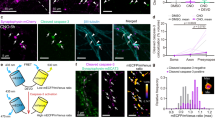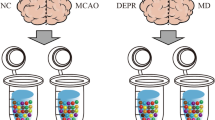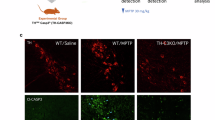Abstract
Increased brain ganglioside levels are a hallmark of various neuroinflammatory pathologies. Here, we provide evidence that murine microglia can secrete disialoganglioside GD3 upon exposure to inflammatory stimuli. Comparison of different neural cell types revealed a particular and specific sensitivity of oligodendrocytes towards exogenous GD3. Oligodendrocyte death triggered by GD3 was preceded by degeneration of cellular processes, and associated with typical features of apoptosis, such as chromatin condensation, exposure of phosphatidylserine, release of cytochrome c from mitochondria, and loss of mitochondrial membrane potential, followed by the loss of plasma membrane integrity and detachment of disintegrated oligodendrocytes. Overexpression of bcl-2 partially protected oligodendrocytes from death. In contrast, treatment with the pan-caspase inhibitor zVAD-fmk did not prevent phosphatidylserine exposure, chromatin margination at the nuclear periphery, and death, although caspase-3 was blocked. Thus, GD3 produced by microglia under neuroinflammatory conditions may function as a novel mediator triggering mitochondria-mediated, but caspase-independent, apoptosis-like death of oligodendrocytes.
Similar content being viewed by others
Log in or create a free account to read this content
Gain free access to this article, as well as selected content from this journal and more on nature.com
or
Abbreviations
- CSF:
-
cerebrospinal fluid
- CGC:
-
cerebellar granule neurons
- CNPase:
-
cyclic nucleotide phosphodiesterase
- cyt c:
-
cytochrome c
- EH-1:
-
ethidium homodimer-1
- FCS:
-
foetal calf serum
- GD3:
-
disialoganglioside 3
- GD1a:
-
disialoganglioside 1a
- GD1b:
-
disialoganglioside 1b
- GM3:
-
monosialoganglioside 3
- LPS:
-
lipopolysaccharide
- MOG:
-
myelin oligodendrocyte glycoprotein
- MPT:
-
mitochondrial permeability transition
- MTT:
-
3-(4,5-Dimethyldiazol-2-yl)-3,5-diphenyltetrazolium bromide
- MS:
-
Multiple Sclerosis
- NO:
-
nitric oxide
- PS:
-
phosphatidylserine
- P/S:
-
penicillin/streptomycine
- TLC:
-
thin layer chromatography
- TMRE:
-
tetramethylrhodamine-ethylester
- TNFα:
-
tumour necrosis factor alpha
- ΔΨm:
-
mitochondrial membrane potential
- zVAD-fmk:
-
N-benzyloxycarbonyl-Val-Ala-aspartyl-fluoromethylketone
References
Kristal BS, Brown AM . 1999 Apoptogenic ganglioside GD3 directly induces the mitochondrial permeability transition J. Biol. Chem. 274: 23169–23175
Pastorino JG, Tafani M, Rothman RJ, Marcineviciute A, Hoek JB, Farber JL . 1999 Functional consequences of the sustained or transient activation by Bax of the mitochondrial permeability transition pore J. Biol. Chem. 274: 31734–31739
Garcia-Ruiz C, Colell A, Paris R, Fernandez-Checa JC . 2000 Direct interaction of GD3 ganglioside with mitochondria generates reactive oxygen species followed by mitochondrial permeability transition, cytochrome c release, and caspase activation FASEB J. 14: 847–858
Rippo MR, Malisan F, Ravagnan L, Tomassini B, Condo I, Costantini P, Susin SA, Rufini A, Todaro M, Kroemer G, Testi R . 2000 GD3 ganglioside directly targets mitochondria in a bcl-2-controlled fashion FASEB J. 14: 2047–2054
De Maria R, Lenti L, Malisan F, d'Agostino F, Tomassini B, Zeuner A, Rippo MR, Testi R . 1997 Requirement for GD3 ganglioside in CD95- and ceramide-induced apoptosis Science 277: 1652–1655
De Maria R, Rippo MR, Schuchman EH, Testi R . 1998 Acidic sphingomyelinase (ASM) is necessary for fas-induced GD3 ganglioside accumulation and efficient apoptosis of lymphoid cells J. Exp. Med. 187: 897–902
Scorrano L, Petronilli V, Di Lisa F, Bernardi P . 1999 Commitment to apoptosis by GD3 ganglioside depends on opening of the mitochondrial permeability transition pore J. Biol. Chem. 274: 22581–22585
Ellison JA, de Vellis J . 1995 Amoeboid microglia expressing GD3 ganglioside are concentrated in regions of oligodendrogenesis during development of the rat corpus callosum. Glia. 14: 123–132
Kawai K, Mori M, Watarai S, Yasuda T . 1994 Immunohistochemical demonstration of ganglioside GD3 in the central nervous system Neurosci. Res. 19: 119–124
Molander M, Berthold CH, Persson H, Fredman P . 2000 Immunostaining of ganglioside GD1b, GD3 and GM1 in rat cerebellum: cellular layer and cell type specific associations [In Process Citation] J. Neurosci. Res. 60: 531–542
Vitry S, Avellana-Adalid V, Hardy R, Lachapelle F, Baron-Van Evercooren A . 1999 Mouse Oligospheres: From Pre-Progenitors to functional oligodendrocytes J. Neurosci. Res. 58: 735–751
Andersson L-M, Fredman P, Lekman A, Rosengren L, Gisslén M . 1998 Increased cerebrospinal fluid ganglioside GD3 concentrations as a marker of microglial activation in HIV type 1 infection Aids Res. Human Retrovir. 14: 1065–1069
Miyatani N, Saito M, Ariga T, Yoshino H, Yu RK . 1990 Glycosphingolipids in the cerebrospinal fluid of patients with multiple sclerosis Mol. Chem. Neuropathol. 13: 205–216
Tarvonen-Schröder S, Blennow K, Lekman A, Fredman P, Räihä I, Sourander L . 1997 Gangliosides and Sulfatide in cerebrospinal fluid in leukoaraiosis Dement. Geriatr. Cogn. Disord. 8: 174–179
Yu RK, Ledeen RW, Eng LF . 1974 Ganglioside abnormalities in multiple sclerosis J. Neurochem. 23: 169–174
Selmaj K, Raine CS, Cannella B, Brosnan CF . 1991 Identification of lymphotoxin and tumor necrosis factor in multiple sclerosis lesions J. Clin. Invest. 87: 949–954
D'Souza SD, Alinauskas KA, Antel JP . 1996 Ciliary neurotrophic factor selectively protects human oligodendrocytes from tumor necrosis factor-mediated injury J. Neurosci. Res. 43: 289–298
Vartanian T, Li Y, Zhao M, Stefansson K . 1995 Interferon-gamma-induced oligodendrocyte cell death: implications for the pathogenesis of multiple sclerosis Mol. Med. 1: 732–743
D'Souza SD, Bonetti B, Balasingam V, Cashman NR, Barker PA, Troutt AB, Raine CS, Antel JP . 1996 Multiple sclerosis: Fas signaling in oligodendrocyte cell death J. Exp. Med. 184: 2361–2370
Dittel BN, Merchant RM, Janeway CA Jr . 1999 Evidence for Fas-dependent and Fas-independent mechanisms in the pathogenesis of experimental autoimmune encephalomyelitis J. Immunol. 162: 6392–6400
Frei K, Eugster HP, Bopst M, Constantinescu CS, Lavi E, Fontana A . 1997 Tumor necrosis factor alpha and lymphotoxin alpha are not required for induction of acute experimental autoimmune encephalomyelitis J. Exp. Med. 185: 2177–2182
Liu J, Marino MW, Wong G, Grail D, Dunn A, Bettadapura J, Slavin AJ, Old L, Bernard CC . 1998 TNF is a potent anti-inflammatory cytokine in autoimmune-mediated demyelination Nat. Med. 4: 78–83
Agresti C, D'Urso D, Levi G . 1996 Reversible inhibitory effects of interferon-gamma and tumour necrosis factor-alpha on oligodendroglial lineage cell proliferation and differentiation in vitro Eur. J. Neurosci. 8: 1106–1116
Mitrovic B, Parkinson J, Merrill JE . 1996 An in vitro model of oligodendrocyte destruction by nitric oxide and its relevance to multiple sclerosis Methods 10: 501–513
Willenborg DO, Staykova MA, Cowden WB . 1999 Our shifting understanding of the role of nitric oxide in autoimmune encephalomyelitis: a review J. Neuroimmunol. 100: 21–35
Pitt D, Werner P, Raine CS . 2000 Glutamate excitotoxicity in a model of multiple sclerosis Nat. Med. 6: 67–70
Smith ME . 1999 Phagocytosis of myelin in demyelinative disease: a review Neurochem. Res. 24: 261–268
Castro-Palomino JC, Simon B, Speer O, Leist M, Schmidt RR . 2001 Synthesis of Ganglioside GD3 and Comparison to Bovine GD3 with Regard to Oligodendrocyte Apoptosis and Mitochondrial Damage Chem. Eur. J. 7: 2178–2184
Jung M, Kramer E, Grzenkowski M, Tang K, Blakemore W, Aguzzi A, Khazaie K, Chlichlia K, von Blankenfeld G, Kettenmann H, Trotter J . 1995 Lines of murine oligodendroglial precursor cells immortalized by an activated neu tyrosine kinase show distinct degrees of interaction with axons in vitro and in vivo Eur. J. Neurosci. 7: 1245–1265
Nicholson DW . 1999 Caspase structure, proteolytic substrates, and function during apoptotic cell death Cell Death Differ. 6: 1028–1042
Leist M, Jaattela M . 2001 Four Deaths and a Funeral: from Caspases to alternative Mechanisms Mol. Cell. Biol. 2: 589–598
Volbracht C, Leist M, Kolb SA, Nicotera P . 2001 Apoptosis in caspase-inhibited neurons Mol. Med. 7: 36–48
Ladisch S, Chang F, Li R, Cogen P, Johnson D . 1997 Detection of medulloblastoma and astrocytoma-associated ganglioside GD3 in cerebrospinal fluid Cancer Lett. 120: 71–78
Ryu BR, Choi DW, Hartley DM, Costa E, Jou I, Gwag BJ . 1999 Attenuation of cortical neuronal apoptosis by gangliosides J. Pharmacol. Exp. Ther. 290: 811–816
Hicks D, Heidinger V, Mohand-Said S, Sahel J, Dreyfus H . 1998 Growth factors and gangliosides as neuroprotective agents in excitotoxicity and ischemia Gen. Pharmacol. 30: 265–273
Koike T, Fehsel K, Zielasek J, Kolb H, Burkart V . 1993 Gangliosides protect from TNF alpha-induced apoptosis Immunol. Lett. 35: 207–212
Svennerholm L, Boström K, Jungbjer B, Olsson L . 1994 Membrane lipids of adult human brain: lipid composition of frontal and temporal lobe in sujects of age 20 to 100 years J. Neurochem. 63: 1802–1811
Colell A, Garcia-Ruiz C, Roman J, Ballesta A, Fernandez-Checa JC . 2001 Ganglioside GD3 enhances apoptosis by suppressing the nuclear factor-kappa B-dependent survival pathway FASEB J. 15: 1068–1070
Schmied M, Breitschopf H, Gold R, Zischler H, Rothe G, Wekerle H, Lassmann H . 1993 Apoptosis of T lymphocytes in experimental autoimmune encephalomyelitis. Evidence for programmed cell death as a mechanism to control inflammation in the brain Am. J. Pathol. 143: 446–452
Stassi G, Todaro M, Bucchieri F, Stoppacciaro A, Farina F, Zummo G, Testi R, De Maria R . 1999 Fas/Fas ligand-driven T cell apoptosis as a consequence of ineffective thyroid immunoprivilege in Hashimoto's thyroiditis J. Immunol. 162: 263–267
Reynolds R, Wilkin GP . 1993 Cellular reaction to an acute demyelinating/remyelinating lesion of the rat brain stem: localisation of GD3 ganglioside immunoreactivity J. Neurosci. Res. 36: 405–422
Heinrich M, Wickel M, Schneider-Brachert W, Sandberg C, Gahr J, Schwandner R, Weber T, Saftig P, Peters C, Brunner J, Kronke M, Schutze S . 1999 Cathepsin D targeted by acid sphingomyelinase-derived ceramide EMBO J. 18: 5252–5263
Joza N, Susin SA, Daugas E, Stanford WL, Cho SK, Li CY, Sasaki T, Elia AJ, Cheng HY, Ravagnan L, Ferri KF, Zamzami N, Wakeham A, Hakem R, Yoshida H, Kong YY, Mak TW, Zuniga-Pflucker JC, Kroemer G, Penninger JM . 2001 Essential role of the mitochondrial apoptosis-inducing factor in programmed cell death Nature 410: 549–554
Li LY, Luo X, Wang X . 2001 Endonuclease G is an apoptotic DNase when released from mitochondria Nature 412: 95–99
Borner C, Monney L . 1999 Apoptosis without caspases: an inefficient molecular guillotine? Cell Death Differ. 6: 497–507
Volbracht C, Leist M, Nicotera P . 1999 ATP controls neuronal apoptosis triggered by microtubule breakdown or potassium deprivation Mol. Med. 5: 477–489
Nicotera P, Leist M, Manzo L . 1999 Neuronal cell death: a demise with different shapes Trends Pharmacol. Sci. 20: 46–51
Raine CS . 1997 The Norton Lecture: a review of the oligodendrocyte in the multiple sclerosis lesion J. Neuroimmunol. 77: 135–152
Bonetti B, Raine CS . 1997 Multiple sclerosis: oligodendrocytes display cell death-related molecules in situ but do not undergo apoptosis Ann. Neurol. 42: 74–84
Schorpp M, Jager R, Schellander K, Schenkel J, Wagner EF, Weiher H, Angel P . 1996 The human ubiquitin C promoter directs high ubiquitous expression of transgenes in mice Nucleic. Acids. Res. 24: 1787–1788
Trotter J, Bitter-Suermann D, Schachner M . 1989 Differentiation-regulated loss of the polysialylated embryonic form and expression of the different polypeptides of the neural cell adhesion molecule by cultured oligodendrocytes and myelin J. Neurosci. Res. 22: 369–383
Bottenstein JE, Sato GH . 1979 Growth of a rat neuroblastoma cell line in serum-free supplemented medium Proc. Natl. Acad. Sci. USA 76: 514–517
Bansal R, Warrington AE, Gard AL, Ranscht B, Pfeiffer SE . 1989 Multiple and novel specificities of monoclonal antibodies O1, O4, and R-mAb used in the analysis of oligodendrocyte development J. Neurosci. Res. 24: 548–557
Knapp PE, Skoff RP, Sprinkle TJ . 1988 Differential expression of galactocerebroside, myelin basic protein, and 2′,3′-cyclic nucleotide 3′-phosphohydrolase during development of oligodendrocytes in vitro J. Neurosci. Res. 21: 249–259
Leist M, Fava E, Montecucco C, Nicotera P . 1997 Peroxynitrite and NO-donors induce neuronal apoptosis by eliciting autocrine excitotoxicity Eur. J. Neurosci. 9: 1488–1498
Jaattela M, Wissing D, Bauer PA, Li GC . 1992 Major heat shock protein hsp70 protects tumor cells from tumor necrosis factor cytotoxicity EMBO J. 11: 3507–3512
Schierle GS, Leist M, Martinou J-C, Widner H, Nicotera P, Brundin P . 1999 Differential effects of Bcl-2 overexpression on fiber outgrowth and survival of embryonic dopaminergic neurons in intracerebral transplants Eur. J. Neurosci. 11: 3073–3081
Leist M, Single B, Castoldi AF, Kühnle S, Nicotera P . 1997 Intracellular ATP concentration: a switch deciding between apoptosis and necrosis J. Exp. Med. 185: 1481–1486
Leist M, Volbracht C, Kühnle S, Fava E, Ferrando-May E, Nicotera P . 1997 Caspase-mediated apoptosis in neuronal excitotoxicity triggered by nitric oxide Mol. Med. 3: 750–764
Graus F, Cordon-Cardo C, Houghton AN, Melamed MR, Old LJ . 1984 Distribution of the ganglioside GD3 in the human nervous system detected by R24 mouse monoclonal antibody Brain Res. 324: 190–194
Acknowledgements
The excellent technical assistance of Elvira Gawlitta-Gorka is gratefully acknowledged. We are grateful to Dr. J Schenkel (Institute of Physiology II, University of Heidelberg, Germany) and Dr. R Jäger (Forschungszentrum Karlsruhe, Germany) for providing bcl-2 transgenic mice, to Dr. T Mürdter (Dr. M Fischer-Bosch-Institute for Clinical Pharmacology, Stuttgart, Germany) for measurements of ceramides by combined gas-chromatography and mass-spectroscopy and to Dr. J Castro-Palomino (Bayer AG, Wuppertal, Germany) and Prof. Dr. RR Schmidt (University of Konstanz, Germany) for chemical synthesis of GD3. This study was supported by the DFG grant We686/18, by AIRC, by ISS Progetto Sclerosi Multiple as well as the EEC grants BMH4CT97-2410 and 12029-97-06 F1ED ISP D. F Malisan was supported by a fellowship from FIRC.
Author information
Authors and Affiliations
Corresponding author
Additional information
Edited by M Piacentini
Rights and permissions
About this article
Cite this article
Simon, B., Malisan, F., Testi, R. et al. Disialoganglioside GD3 is released by microglia and induces oligodendrocyte apoptosis. Cell Death Differ 9, 758–767 (2002). https://doi.org/10.1038/sj.cdd.4401027
Received:
Revised:
Accepted:
Published:
Issue date:
DOI: https://doi.org/10.1038/sj.cdd.4401027
Keywords
This article is cited by
-
Siglec-7 restores β-cell function and survival and reduces inflammation in pancreatic islets from patients with diabetes
Scientific Reports (2017)
-
Leukodystrophies: a proposed classification system based on pathological changes and pathogenetic mechanisms
Acta Neuropathologica (2017)
-
Switching from astrocytic neuroprotection to neurodegeneration by cytokine stimulation
Archives of Toxicology (2017)
-
Disialogangliosides and TNFα Alter Gene Expression for Cytokines and Chemokines in Primary Brain Cell Cultures
Neurochemical Research (2012)
-
Sphingolipids and cell death
Apoptosis (2007)



